

This article is the first in a series of articles, which will detail my project to develop a true CRPG (Computer Role-Playing Game) for the TI-99/4a home computer system.
I suppose I should define what I mean by 'true'...
A CRPG has its roots in the paper-and-pencil RPG's, such as Dungeons and Dragons. The basic structure of such games is that you have variant character types, or classes. A party is implied; while some CRPG's have been done around a single player character, I think that the best CRPG's involve controlling a party of characters. You also have a quest, or a series of quests, that must be completed in order to win the game. And finally, to differentiate it from an adventure game, a true CRPG is written for a more literary audience, and relies on text and story to impart character over graphics and special effects. Which isn't to say it can't look good...
In the modern era of computing, CRPG's have somewhat faded from the limelight. While MMORPG's (Massive Multiplayer Online Role-Playing Games) are still doing well, in particular World of Warcraft, CRPG's have been reduced to a niche audience, and are rarely published by the large developers now.
It's my belief that these games are still a viable genre, and very fun to play. And that one of the elements that made them so good was their strong literary background and their focus on fantasy and science-fiction. And I've always been annoyed that my first and most beloved microcomputer, the TI-99/4a, lacked what other computers of its time had. So, since few others made one, or attempted to do so I will do it myself!
In a forthcoming article, I will make a list of the elements I want to see in my CRPG. For now, I will cover what some of the more inspiring games, both on the TI and not on the TI, have been for me in this genre.
Note: I am not distributing copies of these games. When I can, I will provide links to freeware versions, modern remakes or other similar projects. Some of the TI games can be found at the TI Game Shelf. Cartridge-based games can be found on eBay, and old disk and cassette software can turn up there as well.
While the list of TI games that have CRPG qualities is rather short, many of them do merit mention. They are listed below, in no particular order:
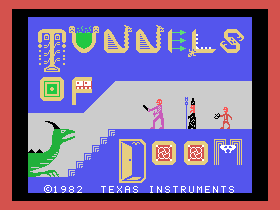 This is the most well-known CRPG on the TI, and in my opinion, the best. It was written by Kevin Kinney, a software developer at Texas Instruments. It stands out as an anomaly in Texas Instrument's line of games, which consisted mainly of arcade clones and remade classic games.
This is the most well-known CRPG on the TI, and in my opinion, the best. It was written by Kevin Kinney, a software developer at Texas Instruments. It stands out as an anomaly in Texas Instrument's line of games, which consisted mainly of arcade clones and remade classic games.
Two games were provided with the original cartridge, on either disk or cassette. The first game, "Pennies and Prizes", offered a simple exploration quest with no monsters, a suitable game for young children, and also a nice tutorial to basic gameplay. The second game, "Quest of the King", was a quest to rescue a captive king and his source of power from a dungeon. It offered four different classes, several dozen types of monsters, and increasingly difficult encounters as you traveled deeper into the dungeon.
 Gameplay consisted of traversing a 3D dungeon, engaging in turn-based tactical 2D combat, and searching for items, treasure, and magic. Games could be customized for number of levels, characters, and difficulty of gameplay. The random generation used for maps and encounters ensured that every game was unique, giving unlimited replay value. A mapping system is provided, so you can see where you've been. Sometimes secret doors into rooms that are adjacent to a corridor can be found. At doors, you could listen to see if any monsters were inside, break them open and move your party fully into the room, or open sedately, leaving your rear party members outside.
Gameplay consisted of traversing a 3D dungeon, engaging in turn-based tactical 2D combat, and searching for items, treasure, and magic. Games could be customized for number of levels, characters, and difficulty of gameplay. The random generation used for maps and encounters ensured that every game was unique, giving unlimited replay value. A mapping system is provided, so you can see where you've been. Sometimes secret doors into rooms that are adjacent to a corridor can be found. At doors, you could listen to see if any monsters were inside, break them open and move your party fully into the room, or open sedately, leaving your rear party members outside.
Combat was very fun. Several dozen monster types exist in the game, possessing various strengths and weaknesses, as well as special attacks, which have a variety of effects on gameplay. Attacks could be in melee, or using ranged weapons, with a nice targeting system that allowed targeting a monster anywhere in the combat zone without friendly fire problems or straight/diagonal issues.
 Sound effects are particularly effective in the game. Monsters have sound effects for appearance and attack, and are varied enough to give each individual monster, despite repetition of sound and graphic, a unique character. A melee hit on a monster has a nice meaty sound, while a miss has a disappointing three-tone jingle. A shot from a ranged weapon streaks across the screen with a hissing noise. Slaying a monster results in a triumphant five-tone jingle. Not until PC games like Diablo have I so enjoyed the sounds of conflict.
Sound effects are particularly effective in the game. Monsters have sound effects for appearance and attack, and are varied enough to give each individual monster, despite repetition of sound and graphic, a unique character. A melee hit on a monster has a nice meaty sound, while a miss has a disappointing three-tone jingle. A shot from a ranged weapon streaks across the screen with a hissing noise. Slaying a monster results in a triumphant five-tone jingle. Not until PC games like Diablo have I so enjoyed the sounds of conflict.
Tunnels of Doom is by no means perfect. Death in the game is simply the exceeding of wounds over hit points. Because you can reduce wounds over time through ration consumption, your dead characters can come back to life unexpectedly. A related amusing bug is that the game has no check for the party being ALL dead outside of combat. You can continue to move around, the game only ends if you run into monsters.
 The class system is fairly underdeveloped as well. Starting and advancing hit points is one, with Fighters and Heroes starting high, rogues less, and wizards low. Rogues and wizards are just limited in weapon and armor usage, compared to the fighter and hero. The rouge has a better chance with trap detection/removal. And the wizard are the only ones who can use scrolls. (Except for the Hero, who has all advantages and no disadvantages, but is only available in single-character play.)
The class system is fairly underdeveloped as well. Starting and advancing hit points is one, with Fighters and Heroes starting high, rogues less, and wizards low. Rogues and wizards are just limited in weapon and armor usage, compared to the fighter and hero. The rouge has a better chance with trap detection/removal. And the wizard are the only ones who can use scrolls. (Except for the Hero, who has all advantages and no disadvantages, but is only available in single-character play.)
Although it was intended that new Tunnels of Doom games would eventually be released, in the end, this function was provided for by 3rd party developers years after TI discontinued their home computer product line. The fundamental flaw with the "ToD Editor", though, is the basic game in itself was not editable. The main quest, to retrieve quest items, could not be changed, only the number of items to retrieve. Graphics, names, and monster statistics could be altered, but many of the games fundamentals such as class abilities and monster special attacks were hard-coded and unalterable. This didn't stop companies such as Asgard from turning out dozens of Tunnels of Doom games.
Tunnels of Doom stands out as a superb example of a well-done game. Like many 99'ers, I still fire it up occasionally to enjoy a trip through those nostalgic tunnels... A company called DreamCodex has created a PC/Java version of this classic game.
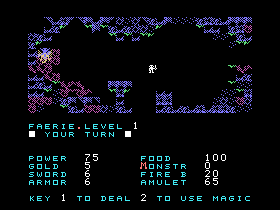 Considered the prequel to Legends, Old Dark Caves was the first commerical product written by Donn Granros and distributed by Asgard Software. I picked up a copy of this from a local TI store, complete with manual on 8.5x11 parchment. Your goal is to explore the caverns and rescue the world's last dragon, which you do by collecing parts of magical artifacts in both the upper and lower caves.
Considered the prequel to Legends, Old Dark Caves was the first commerical product written by Donn Granros and distributed by Asgard Software. I picked up a copy of this from a local TI store, complete with manual on 8.5x11 parchment. Your goal is to explore the caverns and rescue the world's last dragon, which you do by collecing parts of magical artifacts in both the upper and lower caves.
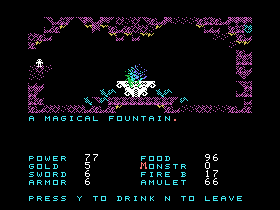 Donn is an artist, and it shows in his work. His graphics have an 'asymmetrical' quality; the patterns don't mirror themselves, and have no simple triangles or squares. Even in emulation and without NTSC interference, his graphics are excellent. The same philosophy of artwork can be seen in Legends as well; I especially enjoy his "mosaic" artwork of a 3D scene rendered with 2D patterns.
Donn is an artist, and it shows in his work. His graphics have an 'asymmetrical' quality; the patterns don't mirror themselves, and have no simple triangles or squares. Even in emulation and without NTSC interference, his graphics are excellent. The same philosophy of artwork can be seen in Legends as well; I especially enjoy his "mosaic" artwork of a 3D scene rendered with 2D patterns.
In the game, you control a single player in game that explores a series of caverns for treasure and quest items, while fighting monsters with both sword and fireballs. It has a similar play to the classic Adventure game on the Atari 2600, or the Legend of Zelda. (Although with turn-based combat).
The game is written in Extended BASIC, and uses machine language routines to speed up various elements of the game, such as the display. The game is split into two parts; the upper and lower caverns, with a general store in-between. (Somewhat reminiscent of Tunnels of Doom with the stores on the 4th and 8th levels.)
Game flaws include a "looping" map. While the map is constant in layout, various exits will connect to other parts, creating an infinite maze. This makes mapping difficult. Items and encounters spawn randomly in the caves, so you can find that in one game you're very lucky, and in others not so much. I have never actually played the game to completion, due to frustration with the purely random nature of it.
However, Old Dark Caves doesn't promise more than a simple action game, and it delivers that very well, considering the platform. A PDF of the instructions can be found here.
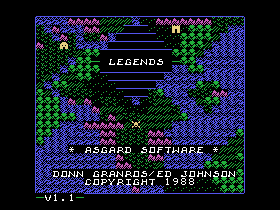 Released by Asgard Software, and written by Ed Johnson and Donn Granros, Legends is the other CRPG on the TI. (Besides Tunnels of Doom...) I found out not long ago that it's actually a small-scale clone of the Phantasie series that was produced in the mid 80's on the Apple, Atari, IBM and C64 systems.
Released by Asgard Software, and written by Ed Johnson and Donn Granros, Legends is the other CRPG on the TI. (Besides Tunnels of Doom...) I found out not long ago that it's actually a small-scale clone of the Phantasie series that was produced in the mid 80's on the Apple, Atari, IBM and C64 systems.
Your mission is to defeat the evil Ashtar Creel, who has used the Book of Magic Spells to open a portal to the Land of the Dead, bringing monsters into the peaceful realm of Edonland, on the planet of Legends. (Edon = Ed and Donn, get it?) His most powerful servants are the dreaded Dark Knights, who stalk the land, demanding tribute. A number of dungeons, the remnants of settlements swallowed by the earth in a series of earthquakes, offer the clues and items you need to complete your quest.
The game starts in the city of Wizard's Rock, which has the distinction of being the ONLY city on the island. You can train your party to new levels, visit the pub to rest and collect rumors, buy potions, and perform other maintenance activities while in town. Once you leave town, your party will be in danger until they return, alive or dead. If you restore a saved game you always start in Wizard's Rock.
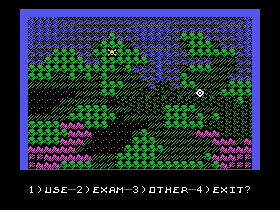 The player controls a party of four characters, consisting of a fighter, ranger, wizard, and cleric. Each class has individual strengths and weaknesses. The fighter, naturally, excels at physical combat, and can evaluate the strength of monsters. The ranger is a jack-of-all-trades; a decent fighter and spellcaster, and is also the best at disarming traps. The wizard is a powerful spellcaster, that deal direct damage with spells or reduce their effectiveness. The cleric has the best healing abilities, a spell that damages undead creatures, and can cast protective spells on party members.
The player controls a party of four characters, consisting of a fighter, ranger, wizard, and cleric. Each class has individual strengths and weaknesses. The fighter, naturally, excels at physical combat, and can evaluate the strength of monsters. The ranger is a jack-of-all-trades; a decent fighter and spellcaster, and is also the best at disarming traps. The wizard is a powerful spellcaster, that deal direct damage with spells or reduce their effectiveness. The cleric has the best healing abilities, a spell that damages undead creatures, and can cast protective spells on party members.
The world consists of multiple screens of terrain, most of which is traversable. Mountains and deep water cannot be passed over. (Please note that some of the water is actually shoals, which you CAN walk on.) Ruins offer entry into the various dungeons. Inns offer sanctuary where your party can recover to full strength. Signs/icons offer details of the region you're in. Teleporters will take you back to Wizard's Rock, if you can guess the code to activate them...
The island is 3 screens deep by 5 screens wide, for a total of 15 screens. (Click here for a map...) Some terrain is more dangerous than others; your random encounters are determined by your terrain. The "dark swamps" mentioned in the pub are a triangle of three points, and can be easily missed until you wander onto one by accident. Stealth potions allow you to wander around unharrassed, but wear off unexpectedly.
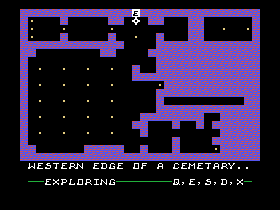 There are two different types of dungeons, and three of each. The first type is devoid of monsters, but has items, traps, and the occasional encounter with someone who can provide information. The second type has monsters that openly guard areas, or lie in wait, as well as minor items such as gold or potions. Traps are especially dangerous, and could slay your entire party in short order.
There are two different types of dungeons, and three of each. The first type is devoid of monsters, but has items, traps, and the occasional encounter with someone who can provide information. The second type has monsters that openly guard areas, or lie in wait, as well as minor items such as gold or potions. Traps are especially dangerous, and could slay your entire party in short order.
While moving around in dungeons, different areas will pop up little descriptions. I find this very neat, as it adds character to a rather plain interface. Dungeons consist of 2-4 screens apiece. You can find entrances to the other sections on the far sides of the screen. You are offered the chance to save the screens, but be warned, your map data is altered permanently on the disk. Always play on copies, not your master disks!
Although a well-done game, Legends has its problems.
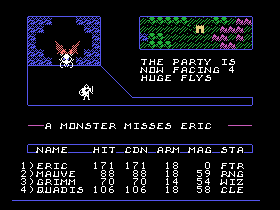 The greatest issue is the extremely slow load times to travel from town to world to dungeon. This is because each seperate area is, in fact, a separate Extended BASIC program! This problem is reduced in emulation, but is still an annoyance.
The greatest issue is the extremely slow load times to travel from town to world to dungeon. This is because each seperate area is, in fact, a separate Extended BASIC program! This problem is reduced in emulation, but is still an annoyance.
I've also noted that some emulators, such as MESS, have problems with the files not getting closed properly. When I saved a dungeon screen, then attempted to resave it a few minutes later, the emulator froze, and when I reset it, the disk file in question was destroyed.
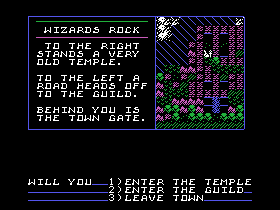 Combat has some problems. Your party is unable to target more than one monster at a time, while the monsters can freely target any of your party. While concentration of attacks on a single enemy IS a good idea, it's nice to have the option to do otherwise. There are also some bugs; the monster encounters in dungeons have a persistence problem with the monsters casting the slow spell. Once slowed, you'll find your party is permanently slowed until you leave the dungeon! (I'm not fond of the "level loss" spell either, but that's more a personal peeve than a bug.)
Combat has some problems. Your party is unable to target more than one monster at a time, while the monsters can freely target any of your party. While concentration of attacks on a single enemy IS a good idea, it's nice to have the option to do otherwise. There are also some bugs; the monster encounters in dungeons have a persistence problem with the monsters casting the slow spell. Once slowed, you'll find your party is permanently slowed until you leave the dungeon! (I'm not fond of the "level loss" spell either, but that's more a personal peeve than a bug.)
Also, while there are different weapons and armor in game, they can only be equiped immediately, with no trading possible. Finding items is completely random. This leads to the tactic of clearing a dungeon level so it consists only of accessible chests. Then you can continually reopen all the chests by leaving and re-entering the dungeon section, never re-saving the screen.
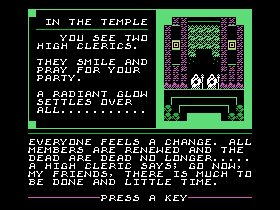 Because of the very high XP requirements for leveling, you spend a large amount of game time just killing monsters for gold and experience. This can get boring very quickly. The difficulty level system offers you the chance to fight stronger versions of all the monsters for more gold and experience, and thus speeding up this process. In this case, though, your best tactic is to just hang around Wizard's Rock until your entire party is very high-level. Most new players like exploration, though, and it can be frustrating to not be able to indulge in this right away.
Because of the very high XP requirements for leveling, you spend a large amount of game time just killing monsters for gold and experience. This can get boring very quickly. The difficulty level system offers you the chance to fight stronger versions of all the monsters for more gold and experience, and thus speeding up this process. In this case, though, your best tactic is to just hang around Wizard's Rock until your entire party is very high-level. Most new players like exploration, though, and it can be frustrating to not be able to indulge in this right away.
Unlike Tunnels of Doom, you are unable to change the basic party composition. You cannot have less or more than four characters, and you must have one of each class. This limits replay value, no "iron man" competitions to see who can get the furthest with a party consisting entirely of wizards, or a lone fighter. (It is possible to just let the other party members die and then fail to resurrect them, but a visit to the temple of Wizard's Rock restores your entire party.)
The final problem, though, is the platform. CRPG's tend to push the limits of the systems they are on to the upmost. For an Extended BASIC program, Legends is impressive. But it is no more complicated than Ultima I, and I know the TI is capable of more than this in low-level languages such as C or assembly. In addition, it only really uses 180k of dataspace, which isn't much even for the TI. This is partially due to Asgard aiming for the lowest-end TI user with a disk system, assuming they would only have single-sided single-density 90k drives. Fortunately, you can copy the game files all onto one large disk if you choose to do so, or even copy them to RAMdisk for faster access.
 Legends II was released a few years after the first game. The game was principally written by Donn Granros; Ed Johnson's name only appears in connection with the routines borrowed from the first game.
Legends II was released a few years after the first game. The game was principally written by Donn Granros; Ed Johnson's name only appears in connection with the routines borrowed from the first game.
The story in Legends II is not as refined as Legends. Having defeated Ashtar Creel, your party has set out to sea in search of new adventures into uncharted oceans. A storm and subsequent shipwreck stripped them of their powerful equipment, and they eventually washed up on shore near a small village, at which your adventure begins. Hints are made in the game that Creel may not be dead after all...
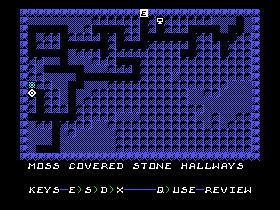 The game engine is virtually identical to its predecessor. It also featured an import utility, allowing you to import your party from Legends into the sequel, a rather nice feature, and useful, since you're unable to generate characters in the game. (The stock parties in BOTH games are very weak, I highly advise not using them.) An interesting bug is that the ranger's armor value is unchanged in import, but its name is changed to "Loincloth". If your ranger had very strong equipment in Legends, then he could end up with a loincloth that was more durable than plate armor!
The game engine is virtually identical to its predecessor. It also featured an import utility, allowing you to import your party from Legends into the sequel, a rather nice feature, and useful, since you're unable to generate characters in the game. (The stock parties in BOTH games are very weak, I highly advise not using them.) An interesting bug is that the ranger's armor value is unchanged in import, but its name is changed to "Loincloth". If your ranger had very strong equipment in Legends, then he could end up with a loincloth that was more durable than plate armor!
The in-game graphics were adjusted, offering new terrain in a wider variety of colors. This is especially noticable in emulation, as the original Legends suffers a little on a non-NTSC display, appearing very stark and bland because most of the terrain colors were green.
The dungeons, instead of having open corridors, are entirely filled in, offering a "fog of war" effect. As you explore, you uncover the corridors. Traps are no longer in corridors, although falling debris can injure you. Chests are more intricate, bringing up a nice portrait of a chest, and can contain multiple items randomly determined. World areas are occasionally guarded by monsters, and some areas are "safe havens" that you can rest safely in for 24 hours. (Resting was also added, as there are no inns on the island.)
However, basic gameplay is unchanged, and the world map is disturbingly linear, offering only a long north-south island with, again, a single city, the village of Grumble. (Click here for a map...) I wrote a letter to Asgard about the game once and they told me they deliberately simplified the sequel due to complaints. I suppose only having one direction to go is simple, but it's also rather dull. The ending is also a little cornball, which I will not comment upon here to prevent spoilers. Another tidbit that Asgard gave me was that the sequel sold very poorly, and that it was unlikely there would be a third installment.
One particular frustration was the in-game puzzle, provided to you on inserts with the game manual. Guardians in the last dungeon require passwords in order to pass by them without a fight. Eventually, you discover the right passwords in-game, but much to my shock, only the first password works. Fortunately, you CAN fight the guardians, but it is a very difficult battle to win. I always wondered if it was a bug that the passwords weren't working, or if it was intentional that they didn't work.
Despite it all, though, Legends shares the spot next to Tunnels of Doom for the best CRPG than can be had on the TI. Here's PDF's of the manuals for Legends and Legends II.
 Released by Rainbow Software, Wizard's Lair is a 3D dungeon game written in 16k Extended BASIC. You are an adventurer that must enter the dungeon of the evil wizard and slay him. The game generates random levels, offering different gameplay each time. Combat is simple, consisting of holding a key down to slash your weapon. There is various magical potions, armor, and weapons to be collected, and monsters to fight.
Released by Rainbow Software, Wizard's Lair is a 3D dungeon game written in 16k Extended BASIC. You are an adventurer that must enter the dungeon of the evil wizard and slay him. The game generates random levels, offering different gameplay each time. Combat is simple, consisting of holding a key down to slash your weapon. There is various magical potions, armor, and weapons to be collected, and monsters to fight.
 I have a fondness for this game, possibly because I remember the errie quiet as I played, using only a cassette recorder to load the game. The sound effects have a creepy quality to them, as well as the almost real-time nature of the game, as monsters can occasionally wander towards you, placing you in combat at a moment's notice. It is pretty obvious that it was inspired by Dungeons of Daggorath. (Described in detail below...)
I have a fondness for this game, possibly because I remember the errie quiet as I played, using only a cassette recorder to load the game. The sound effects have a creepy quality to them, as well as the almost real-time nature of the game, as monsters can occasionally wander towards you, placing you in combat at a moment's notice. It is pretty obvious that it was inspired by Dungeons of Daggorath. (Described in detail below...)
Flaws are minimal. The use of only one monster graphic for all monster types, a goblinish creature, is a bit disappointing. (Except, of course, for the ghost, which is invisible.) The swishing of your weapon gives no indication if you struck the monster or not. Navigation is cumbersome and occasionally slow. The scoring system and treasure chests, offering only points to collect, are not really connected to the mission and seem a tack-on. The map is not too useful for navigation, offering solid blocks that give little indication of where you are and what's around you. And the downtime between levels to generate the next one is rather long, 3-5 minutes at times.
The sequel, Wizard's Revenge, offers similar gameplay with many welcome refinements. Instead of four levels there are five. The dungeon walls are more intricate and detailed. The combat system actually indicates when you hit or miss, and the monsters have varied graphics, which is welcome. Navigation is easier with added commands for quick manuveuring. On the downside, it still has the score system, and the map is as useless as ever.
For its platform, both games are impressive pieces of commercial software, two of the better 3rd party developer products for the TI.
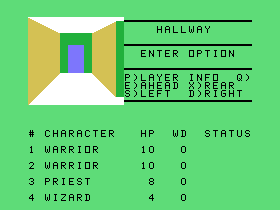 Released by Symbiotech, this game was only available for a short time in the Fall 1985 Triton catalog. Doom of Mondular has the distinction of having the nastiest copy protection ever to exist for the TI. The program is encoded on disk using a proprietary special format, which could not be copied by any disk manager at the time. It was eventually cracked after a great deal of effort using a sector editor, allowing us to play it in emulation today. (The program Copy-C apparently works as well.) The manual says something about the game being "modified" to run on a TI-99/4a, it may have been developed for a different microcomputer entirely.
Released by Symbiotech, this game was only available for a short time in the Fall 1985 Triton catalog. Doom of Mondular has the distinction of having the nastiest copy protection ever to exist for the TI. The program is encoded on disk using a proprietary special format, which could not be copied by any disk manager at the time. It was eventually cracked after a great deal of effort using a sector editor, allowing us to play it in emulation today. (The program Copy-C apparently works as well.) The manual says something about the game being "modified" to run on a TI-99/4a, it may have been developed for a different microcomputer entirely.
According to the manual, your party, residents of the realms of Agnar, have entered the Dungeon of Dread, in order to retrieve the Staff of Power in order to release their village of Mondular from a centuries-old curse, which was cast by a wicked wizard named Zarka, who obtained a powerful magical ring from the Tower of Loom. The game was to be the first in a series of dungeon-based games.
I have only played this game briefly, as it does not run very well on a base TI or in emulation. It is written in Extended BASIC with machine language extensions and a rather unique loader. At times, it exhibits very odd behavior. For example, if the program crashes back to Extended BASIC, the prompt becomes a line number, and it throws errors as if you're attempting to write programs. Very strange indeed!
The game itself is a simple 3D dungeon crawl with abstract combat. The 3D display reminds me of the old Wizardry series on the Apple II. However, no illustrations of monsters are shown, and the only item that appears in-game is a chest. Combat is turn-based, and spells are referred to with numbers, which aren't detailed anywhere but the manual. (Which was, in rumor, printed on red paper to prevent photocopying.)
I honestly haven't tried to play the game for very long or very far, because it is distinctly uninteresting. The frequent crashes make it difficult to keep playing. You don't appear to have control of your party's make-up. There are few sound effects; the manual says that sounds are used to indicate clues of some kind, but I haven't heard any yet. And the graphics aren't particularly impressive.
There were apparently two sequels/side-line games written, Staff of Power and Ring of the Dark Lord. Unfortunately, I know no one who has ever seen or played these; they may have been vaporware. There was also multiple versions of the game, rated in difficulty. It has been commented that the developers would have profited better had they spent more time focusing on making a better game, rather than attempting to protect it.
 From the United Kingdoms, written by David Vincent, this isn't exactly a CRPG, more of a puzzle/maze based adventure game. However, it is still an excellent game.
From the United Kingdoms, written by David Vincent, this isn't exactly a CRPG, more of a puzzle/maze based adventure game. However, it is still an excellent game.
 Your goal in the game is to slay Count Dracula, who has taken up residence in Carfax Abbey. You must find the necessary tools to slay Dracula while protecting yourself from him by exploring the abbey for items to aid your quest.
Your goal in the game is to slay Count Dracula, who has taken up residence in Carfax Abbey. You must find the necessary tools to slay Dracula while protecting yourself from him by exploring the abbey for items to aid your quest.
The abbey is actually a 3D cube of rooms, 5 levels deep, and consisting of 5x5 rooms (25 total) per level. There are doors, locked doors, secret passages, lifts, and stairs that connect the rooms and levels. Typically, rooms contain boons or banes that grant you bonuses or penalties to your energy level. Exploration increases energy, but back-tracking reduces it, as does using secret passages. The game offers 1000 different layouts of the abbey, which allows you to replay a maze, and gives quite a bit of replay value.
Like Legends, it is an Extended BASIC game that uses machine language extensions for speed. The exotic font used in game is particularly nice, it is a nice change from the normal TI font. The game also has complete documentation on disk, very useful in these days of emulation.
Flaws include the possibility of an unsolvable maze, where your starting location puts you in a position that makes you unable to move forward, or worse, throws you into Dracula before you have anything to stop him with. The energy penalty for back-tracking is also annoying, especially if you don't have many places to go. I've been trapped in a small section of the maze because I lacked keys to open numerous locked doors.
Despite the frustrations, Carfax Abbey is an impressive bit of work, and worth checking out.
 Written by Quinton Tormanean and released by Comprodine software, this short but sweet 3D dungeon crawl is very fun. Although the writer has long since departed the TI community, his work lives on.
Written by Quinton Tormanean and released by Comprodine software, this short but sweet 3D dungeon crawl is very fun. Although the writer has long since departed the TI community, his work lives on.
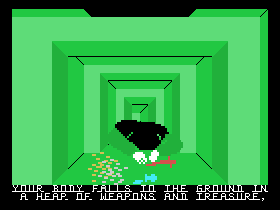 Living Tomb plays more arcade than CRPG; it is entirely controlled by joystick. Combat consists of hitting the fire button rapidly to attack foes, the menu-driven control system can be brought up by pressing fire while pulling back on the joystick. Navigation is assembly-quick, a vast improvement over Tunnels of Doom's 3D engine. (ToD clearly shows it's GPL roots, unfortunately.)
Living Tomb plays more arcade than CRPG; it is entirely controlled by joystick. Combat consists of hitting the fire button rapidly to attack foes, the menu-driven control system can be brought up by pressing fire while pulling back on the joystick. Navigation is assembly-quick, a vast improvement over Tunnels of Doom's 3D engine. (ToD clearly shows it's GPL roots, unfortunately.)
Unlike Wizard's Lair, monsters don't move around. This gives you some leeway in exploration, as you can avoid fights you may have trouble winning. However, the dungeon is also full of traps, which can cause damage to you as you travel. Some secret passages exist, so it's a good idea to check the in-game map (very well done) and see if you may have missed something.
The game also offers a rare treat for the TI: cinematics. When you die, you get to see a short display of your hero falling to the ground. When you win the game, you see his triumph over the forces of evil. If you have a speech synthesizer, you also have some speech thrown in.
On the downside, the game is over far too quickly. There are only three dungeon levels, and they are static in nature. There is no variant of difficulty for the game either. So after you've played it once, you need never play it again. Combat's a little annoying, since it consists of punching the fire-button rapidly. On my Epyx 500XJ joystick, this can cause some finger strain.
Still a great game, though. I met Quinton at the TI Faire in Portland, Oregon in 1993, and he showed me one of his works in progress... a Gauntlet clone called Gold Vault, which never saw release. Would that I have asked for a copy... *sob*
Although not developed or released on the TI, a number of games have served as inspiration for CRPG development. If I missed any classics, it's probably because I haven't really played them. A short list of my favorites is below:
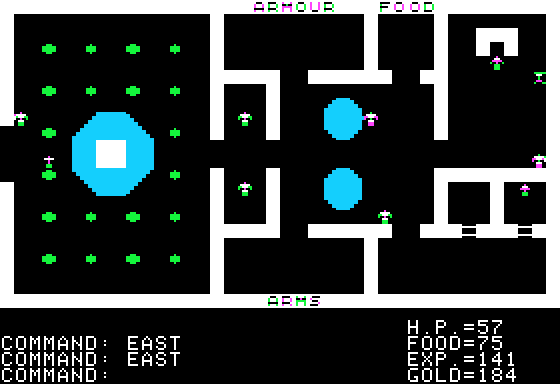 This is, of course, the penultimate of CRPG's on the home computer. Created by Richard Garriot and developed on the Apple II, it was the inspiration for many CRPG's to follow, even the contemporary Final Fantasy series on modern consoles. Ultima introduced many elements common to CRPG's: a 2D scrolling map, 3D dungeons, epic quests, and even better, an open-ended non-linear game world. I only cover the first five here, because they all ran on 8-bit systems that were contemporary to the TI.
This is, of course, the penultimate of CRPG's on the home computer. Created by Richard Garriot and developed on the Apple II, it was the inspiration for many CRPG's to follow, even the contemporary Final Fantasy series on modern consoles. Ultima introduced many elements common to CRPG's: a 2D scrolling map, 3D dungeons, epic quests, and even better, an open-ended non-linear game world. I only cover the first five here, because they all ran on 8-bit systems that were contemporary to the TI.
The primary inspiration Ultima provides is in the accessories that came with the game. A cloth map, using runic scripting, was provided in every game from Ultima II onwards, and became a staple of the genre. Even modern PC CRPG's offer a map with the game because it is expected of a "classic" CRPG to do so. The manuals were written in a story format, and did not provide all the details of the game. The player was left to discover the game for themselves. The knick-knacks, such as coins or stones, also served as collectibles that are still valuable on eBay today.
 Ultima I was, interestingly, written in AppleSoft BASIC with machine language extensions. Very similar to how Legends runs on the TI! It was re-released after Richard Garriot recovered the publishing rights and re-written in 100% assembly for a variety of platforms.
Ultima I was, interestingly, written in AppleSoft BASIC with machine language extensions. Very similar to how Legends runs on the TI! It was re-released after Richard Garriot recovered the publishing rights and re-written in 100% assembly for a variety of platforms.
From Ultima III onwards, music was also available, which played in-game, and with different tunes for different places/events. The Apple II needed a MIDI synthesizer hooked up to play music, but the C64 and Atari versions offered sound chip music. The problem, though, was the music got annoying very quickly, and you usually turned it off after a short time. In addition, disk accesses tended to pause the music, which happened frequently in Ultima IV-V.
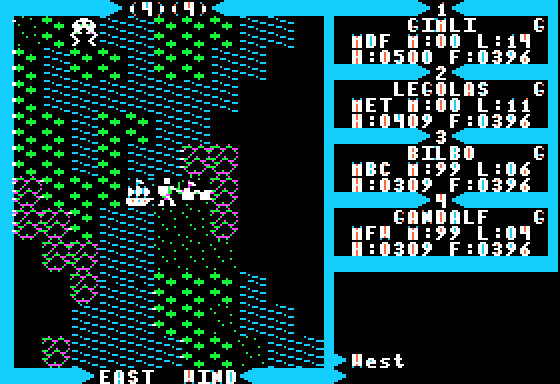 Ultima IV also stands out as the first CRPG to challenge the player to be a virtuous hero. The earlier Ultima games allowed theft and attack upon innocent civilians, and even the king, Lord British. (Typically a futile action, as British was rendered indestructible in all Ultima games, although many players found ways to do him in.) The system of virtues, a unique and interesting philosophy, forms the core of the game's culture and influence, and continues to influence game designers today.
Ultima IV also stands out as the first CRPG to challenge the player to be a virtuous hero. The earlier Ultima games allowed theft and attack upon innocent civilians, and even the king, Lord British. (Typically a futile action, as British was rendered indestructible in all Ultima games, although many players found ways to do him in.) The system of virtues, a unique and interesting philosophy, forms the core of the game's culture and influence, and continues to influence game designers today.
In Ultima IV and V, intricate conversations could be had with the characters in game. Every NPC had a name, and provided a small clue of information. By supplying keywords learned in the course of your journey, you could learn new secrets. Some of the NPC's, especially in Ultima IV, ask ethically challenging questions to test your Virtue, and your Virtue scores are adjusted based upon your answers.
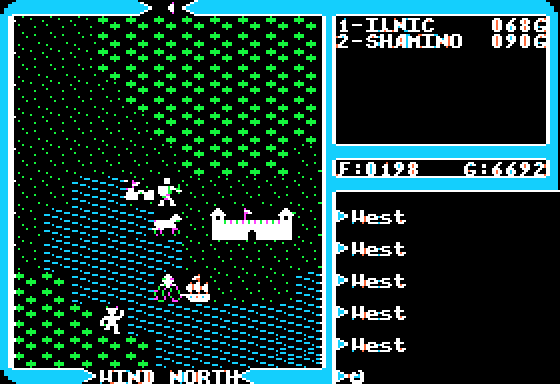 The flaws of the Ultima line varied. One particular element they all shared was a dependence on their manuals for a lot of the game controls and background. They used a key letter system for commands, which if you weren't familiar with them, would make play very difficult. In particular, the early Apple II didn't have up and down arrow keys, so some versions of Ultima use the backslash and return key to move up and down. The first three Ultimas also allowed the player to steal and kill pretty much anyone, which depending on your point of view is either good or bad.
The flaws of the Ultima line varied. One particular element they all shared was a dependence on their manuals for a lot of the game controls and background. They used a key letter system for commands, which if you weren't familiar with them, would make play very difficult. In particular, the early Apple II didn't have up and down arrow keys, so some versions of Ultima use the backslash and return key to move up and down. The first three Ultimas also allowed the player to steal and kill pretty much anyone, which depending on your point of view is either good or bad.
Ultima I, in its original incarnation, runs very sluggishly with a lot of visible refresh. The outer-space scenario, which is a completely different game, required a lot of manual dexterity, and was easy to lose in an instant. Many of the towns share the same layouts, and feature rather repetitive activities.
 Ultima II offered excellent gameplay (fast loading maps, a simple but satisfying combat system) but was rather sparse with in-game text, and the real world cross-over materials and space-age items are a little corny. The dungeons and towers in game serve no useful purpose in the game, which is just as well since they aren't fun to enter anyway. It's hard to play on modern systems as well, because of emulation issues.
Ultima II offered excellent gameplay (fast loading maps, a simple but satisfying combat system) but was rather sparse with in-game text, and the real world cross-over materials and space-age items are a little corny. The dungeons and towers in game serve no useful purpose in the game, which is just as well since they aren't fun to enter anyway. It's hard to play on modern systems as well, because of emulation issues.
Ultima III has a terrible user interface for party control, and you spent a good deal of time in-game just raising money to raise your character attributes to maximum for the final fight. The in-game text was rather sparse as well, although the culture of the game was starting to emerge.
Ultima IV's virtue system was confusing at times; it wasn't always clear how you could advance in one virtue or another. Killing civilians or using an evil artifact could also permanently lose the game for you, because it would lower your virtue standings to the level of impossibility to raise again. The game also ran really slow on 8-bit systems.
Ultima V, distributed over seven disks, required frequent disk swapping. On an Apple II, the game was nearly impossible to play due to practicality issues. Apparently the game's engine took up enough space on an Apple II that some of the code processes are stored on disk, and only loaded as needed.
Despite this, Ultima remains, to me, the quintessential formula of the CRPG genre.
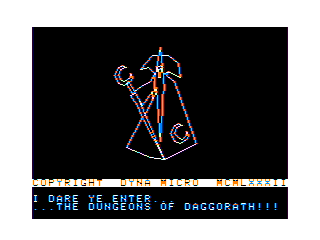 A cartridge-game released by Radio Shack for the TRS-80 Color Computer, Dungeons of Daggorath runs in an 8k ROM, but manages to deliver some of the best FPS gameplay there ever was. In this case, though, FPS means "First-Person Slasher".
A cartridge-game released by Radio Shack for the TRS-80 Color Computer, Dungeons of Daggorath runs in an 8k ROM, but manages to deliver some of the best FPS gameplay there ever was. In this case, though, FPS means "First-Person Slasher".
At the beginning of the game, pixels would collalese to form the evil wizard, his robes marked with the crescent moon, and he challenges you to enter his domain. If you die, he reappears, and snickers with the comment "And yet another does not return..."
The game is a 3D dungeon crawl, similar to Wizard's Lair, but utilizing bitmap graphics. Your light source determines how much is visible, and the corridors will become blurry and unseen as your light dims. Instead of statistics, your sole indicator is a beating heart, which beats slowly when you were well, and beats faster as you move too quickly, take damage, or used spells and various items. Sometimes, if the strain is too much, you faint.
Monsters are made of bitmap graphics and make distinctive sounds (a rattle for a snake, a stony thump for a giant) that get louder as the near... and all monsters will wander, and eventually find you. As you defeat the denizens of the dungeon, you become stronger, and more capable of fighting the enemies on the next level.
The game is controlled through the keyboard, typing in commands, such as "GET RIGHT SWORD", "MOVE FORWARD" or "INCANT RING". There are shortcut versions of each word, so you can type quickly, but part of the challenge is reacting quickly, as all combat is in real-time. (And complicated by the relative slowness of the TRS-80 machine, as it has to devote CPU time to sound processing.)
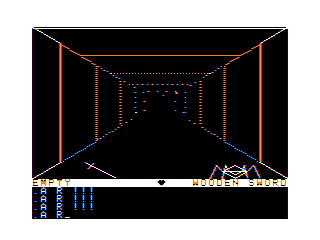 Items in the game tended to be mysterious and unexplained, before you can use them you must reveal them for what they are. Flasks can boost your power, reduce damage, or cause damage, their names are the clue to their function. Rings are mighty artifacts that do great damage to your enemies, but must be incanted with the proper keyword before they can be used. In fact, the wizard himself carries a powerful ring, which must be incanted with the right word to win the game. You won't find the solution anywhere online; the winners have an unspoken conspiracy to keep it secret.
Items in the game tended to be mysterious and unexplained, before you can use them you must reveal them for what they are. Flasks can boost your power, reduce damage, or cause damage, their names are the clue to their function. Rings are mighty artifacts that do great damage to your enemies, but must be incanted with the proper keyword before they can be used. In fact, the wizard himself carries a powerful ring, which must be incanted with the right word to win the game. You won't find the solution anywhere online; the winners have an unspoken conspiracy to keep it secret.
The dungeon had five levels, each level becomes progressively more difficult. On the third level, you must fight the wizard's image, and following the battle you are teleported to the fourth level, with only what you have in your hands. On the fifth level is the wizard himself, the greatest challenge. Should you win the game, you will see a new wizard, yourself, his robes emblazoned with the rising sun... a fitting analogy, as the player has completed the journey from a novice to a master, and the cycle begins anew...
The true strength of the game lies in its atomsphere. The tension of the game raises with the heartbeat, and you may find yourself breathing harder as you traverse the dark corridors. You'll strain your ears to hear the monsters as they approach, trying to discern one from another, and see if you must run from an encounter you can't win. This was one of the first (and few) games to actually scare me.
The game does have flaws. The key controls are difficult to use and master. It has a lousy save system that only permits the use of a cassette, and isn't very reliable. The graphics, being in only two colors, are fairly stark, even for the era it was developed in. And the game is HARD. Winning Dungeons of Daggorath is an accomplishment worthy of awe.
Incidentally, the word "Daggorath" from Tolkien-elvish loosely translates to "Battles". So the literal name of the game is "Dungeon of Battles". You can download an excellent PC version of the game from here.
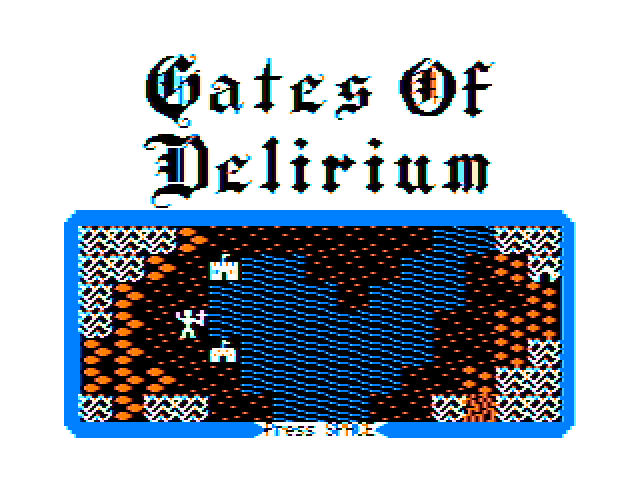 Another game on the TRS-80 Color Computer, this Ultima III/IV clone was released by Diecom products. It saw limited distribution, and only recently surfaced on a CoCo forum in a deluxe package made by a dedicated fan. There is a mood music CD by the same name that tends to confuse search engines...
Another game on the TRS-80 Color Computer, this Ultima III/IV clone was released by Diecom products. It saw limited distribution, and only recently surfaced on a CoCo forum in a deluxe package made by a dedicated fan. There is a mood music CD by the same name that tends to confuse search engines...
The game manual is surprisingly sparse on background. The player can create a single character with four statistics, and choose from five races and eight classes. There are two types of magic spells, and six spells in each category. In all cases, they are clearly inspired by Dungeons and Dragons. The manual cover also features a ghoulish creature that I recognize as the illustration for a ghoul from the Advanced Dungeons and Dragons 1st Edition Monster Manual. As you play, you can collect more party members from the various towns and castles, to a maximum of six.
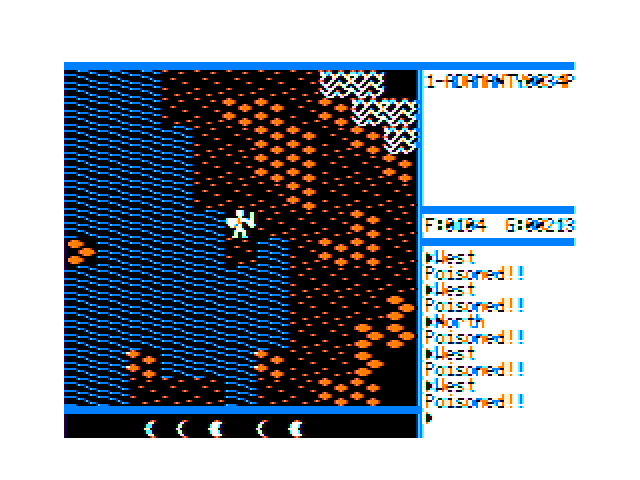 The game looks and plays like Ultima, other than the fact it's in four colors instead of six (as the Apple II version was) and, interestingly, writes black text on a white background instead of the opposite. An early magazine ad had the interface looking more like Ultima I-II in design, but the released game is modeled on Ultima's III-IV. A signifigant difference from Ultima is that the dungeons are also 2D maps like the towns, a welcome change!
The game looks and plays like Ultima, other than the fact it's in four colors instead of six (as the Apple II version was) and, interestingly, writes black text on a white background instead of the opposite. An early magazine ad had the interface looking more like Ultima I-II in design, but the released game is modeled on Ultima's III-IV. A signifigant difference from Ultima is that the dungeons are also 2D maps like the towns, a welcome change!
Game flaws, are, well, it's too MUCH like Ultima. A lot of Diecom's products for the Color Computer were simply recreations of other games. The problem is that this lacks a lot of originality. Compared to Dungeons of Daggorath, which is fondly remembered by a lot of gamers, Gates of Delirium is almost completely unheard of. It's like having an artist who can reproduce a Van Gogh painting to near-perfection, but is completely unable to create his own original work.
Diecom also had a contest going, with the first person winning the game to receive a Color Computer 3. (An excellent prize for a Color Computer enthusiast at the time.) A nice idea for a CRPG, and a clever marketing strategy, but given the obscurity of the title, I don't think it went too well.
Recently, a friend of mine from Armchair Arcade did a 'slog' of Gates of Delirium. Slog is the site's nickname for a live blogging of playing through an old computer or console game. The experience was interesting, because the game turned out to be almost pure torture to play through, thanks to old school mechanics, irreversable puzzles that could permanently wreck the game, and a decided lack of story, plot, or character. He managed to win through to the end, though. You can read about his experiences starting here.
You can download the fan-created package from here, playable in most emulators.
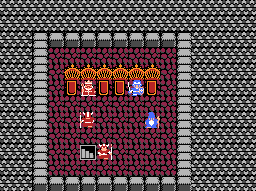 The Dragon Quest series, released in the U.S. as Dragon Warrior, was originally developed on the MSX line of personal computers in Japan, and later released for the Nintendo Entertainment System. This is especially interesting as the MSX systems used the same video chip as the TI! Screenshots of DQ, though, don't look very flattering in comparison to the NES versions, and most of the series was produced on the MSX2, which used a V9938.
The Dragon Quest series, released in the U.S. as Dragon Warrior, was originally developed on the MSX line of personal computers in Japan, and later released for the Nintendo Entertainment System. This is especially interesting as the MSX systems used the same video chip as the TI! Screenshots of DQ, though, don't look very flattering in comparison to the NES versions, and most of the series was produced on the MSX2, which used a V9938.
The story in the games follows a typical hero's quest model. You control a single hero (a party in II onwards) who must defeat an evil villian. Not a complicated plot, obviously. There was a background story of a mighty hero of the past, Erdrick, that your character is choosing to emulate. (In fact, in the third installment, you ARE Erdrick, although you don't become aware of this until the latter stages of the game.)
Even though they were console-based, and rather simple in design, I find a lot of the elements of Dragon Quest to be worthy of attention. The slow increase of monster power and strength as you ventured further from towns and castles helped the player pace himself. The item system in game was very intricate, and allowed the player to carry and trade items easily within his party. And the semi-linear quest system kept the player moving in the right direction, while still leaving him the freedom to explore.
Flaws to the series include a fairly static class system; this improved with the 3rd game onwards. The combat engine, consisting of enemy pictures, was less tactical than other CRPG's. A real annoyance was that monsters were generated in groups. A melee attack would strike a random monster in a group, while some spells would only affect a single group. A confusing system that usually meant you were unable to concentrate fire on any single monster. Hit points for your characters are low in comparison to other CRPG's. Multiple battles can kill your party in short order, even if they're not particularly challenging. For long overland trips, items exist in-game to reduce monster random attacks, and they are absolutely needed.
I still find playing Dragon Quest a fun activity, it's too bad the modern installments of this line just can't equal the originals for fun.
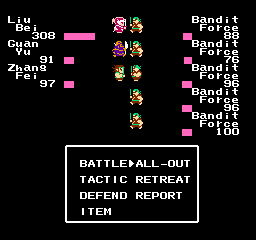 This rather obscure NES game is an interesting change of pace; it is a loose interpretation of the "Romance of the Three Kingdoms", the 16th century Chinese novel. The story focuses upon the sundering of the Han empire of China in the late 1st century into three separate kingdoms, and the heroic efforts of heroes to reunite the empire.
This rather obscure NES game is an interesting change of pace; it is a loose interpretation of the "Romance of the Three Kingdoms", the 16th century Chinese novel. The story focuses upon the sundering of the Han empire of China in the late 1st century into three separate kingdoms, and the heroic efforts of heroes to reunite the empire.
The game itself plays very much like Dragon Quest, with some differences. There are no classes in the game. Instead, there are 120 different 'warlords'. They are differentiated by two statistics, strength and intelligence. Instead of hit points, they have "armies", which indicate the number of troops they have. Some of the warlords gain more armies as the party levels, and others do not. Strength, and army size to a lesser degree, determine damage in combat. Intelligence determines the number of tactical points the warlord contributes if he is the designated 'tactician', which allows him to cast the equivalent of magic spells.
Gameplay is like a standard CRPG, with the player traveling to progressively larger and more difficult areas, and fighting bandits, pirates, rebels, and rogue warlords. If he defeats warlords in combat, he occasionally captures them and can convert them to his side. The really valuable warlords are the classic heroes of the saga, also known as the Five Tigers. The story and plot loosely follows the original story of the novel, but diverges signifigantly at the halfway point.
The game has few flaws in terms of gameplay; some of the quest-oriented elements are a little hacked in. In one scenario, a particular warlord is needed to get by a character in a town. He becomes unavailable after a short time, and so you can never cross to the other side of town after that. The other problem is more literary; the game abandons the original storyline of the novel and actually twists it to a "happy" ending with the heroes emerging triumphant. The older heroes, instead of dying, are either retired or simply stick around. I suppose they had to do this because of Nintendo's family policies, but it's definitely a betrayal of the novel's intent.
There is also a sequel to the game, which was never released in the U.S., but can be occasionally found as a ROM translated to english. It offers some more in-depth encounters based on the original novel, and variant graphcis, but is otherwise similar in style. It also has the "happy" ending.
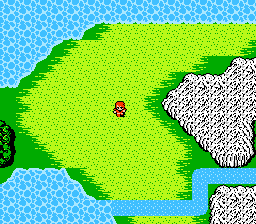 Released by SquareSoft on the NES, and later the MSX2 system, this title certainly needs no introduction to veteran CRPG'ers. Final Fantasy had its roots on 8-bit systems, and to be honest, I much prefer the first incarnation to any of the flashy cinematic editions of today.
Released by SquareSoft on the NES, and later the MSX2 system, this title certainly needs no introduction to veteran CRPG'ers. Final Fantasy had its roots on 8-bit systems, and to be honest, I much prefer the first incarnation to any of the flashy cinematic editions of today.
In the game, the four orbs of the elements have gone dark, their power stolen. And four fiends have stolen that power and using it to slowly destroy the world. But a prophecy declared that four warriors of light shall come forth bearing the darkened orbs and would defeat the fiends, restoring the power of old and vanquishing evil. This, of course, is your party. (A very humorous web-comic, 8-bit Theatre, uses the graphics and storylines from this game, it's worth checking out.)
There are six classes in the game, and two magic systems. The original magic system was similar to Dungeons and Dragons, with spell "slots" indicating how many castings of a particular spell level you can make. White magic is healing, defensive, and protective magic, while black magic is destructive and debilitating. The red mage is unique in that he can cast both white and black magic, and also wear armor and use weapons like a fighter.
 Gameplay is similar to other CRPG's, with a top-down scrolling map. (Although on the NES you enjoy a smooth-scrolling full-screen map.) Displays and menus are on seperate screens, which gives the game a more immersive effect. Combat is portrait style, with your party lining the screen on the right with the greater left of the screen devoted to monster portraits, similar (and superior) to Legends, but without animation. The engine has some flaws; if you target an enemy with one character that is subsequently killed, that player attacks nothing that round.
Gameplay is similar to other CRPG's, with a top-down scrolling map. (Although on the NES you enjoy a smooth-scrolling full-screen map.) Displays and menus are on seperate screens, which gives the game a more immersive effect. Combat is portrait style, with your party lining the screen on the right with the greater left of the screen devoted to monster portraits, similar (and superior) to Legends, but without animation. The engine has some flaws; if you target an enemy with one character that is subsequently killed, that player attacks nothing that round.
Like most NES games, Final Fantasy has full music that plays constantly. The music, all of which is original pieces, is very well done and gives the game a unique character. Even the battle sequences have unique themes that have been repeated throughout the series, and the "victory" tune has stayed consistent throughout the series.
Although the game's storyline and quests are static, players have improvised a number of variations on the game over the years. A favorite is to create mono-class parties, such as all black mages or fighters, and see how long it takes to win the game (if you can) with that combination. Another is to do the main quests, defeating the elemental fiends, out of order to see if the game engine can be broken.
Flaws include a clumsy UI; one particular annoyance was the inability to buy quantities of items, you were forced to select and buy them one at a time. This made getting 99 heal potions a trial for the fingers and thumbs. In addition, the game's level/experience scale is very slow. It can take a long time and many battles to build up enough gold and experience to deal with the threats the storyline requires of you. Some of the in-game items with elemental affiliations, like the fire sword, don't actually do extra damage to water/ice creatures, because that part of the engine was unimplemented. Finally, the english translations aren't always on, partially due to the lack of memory space. In one case, a dwarf says "Hurray!" when it was meant to say something closer to "Lali ho!"
The NES game comes up frequently on eBay. You can play a revised version of the game on the Gameboy Advance and Playstation platforms, which features better graphics and music as well as easier gameplay.
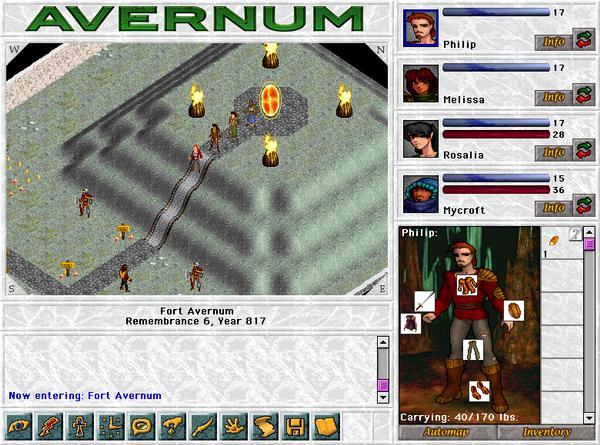 This Mac/PC game series was developed by Spiderweb Software, a small-scale games company. Avernum is the 3D-isometric improved version of the Exile series, also developed by the same company. It is a classic CRPG written on modern systems, and features great gameplay and superb quests.
This Mac/PC game series was developed by Spiderweb Software, a small-scale games company. Avernum is the 3D-isometric improved version of the Exile series, also developed by the same company. It is a classic CRPG written on modern systems, and features great gameplay and superb quests.
The story is that your party are exiles to the underground world of Avernum, a prison for the evil Empire that controls the surface. Dissidents and criminals are banished there to eck out lives in a vast underground labyrinth of caverns. In the first game, your party works their way to becoming the greatest heroes Avernum has known, and eventually slays the Emperor of the Empire. In the second game, the Empire strikes back with an invasion force, forcing the Avernites to ally with a mysterious alien race to slay the chief wizard of the Empire, ending the threat. In the third game, the party travels to the surface on an expedition. The imperial province they emerge into, though, is beset by chaos from mysterious forces. The fourth game features a new graphics engine, and is the first Avernum not connected to the Exile series.
Gameplay is turn-based, and offers a great deal of fun with tactical combat. The class system is very loose, allowing you to fully customize your characters. The 2nd game onwards offers different races as well, giving you more options. Weapons are classified by material, so a steel sword does more damage than a stone one. A sophisticated quest engine gives the player plenty to do, and the player is free to explore most of Avernum without fear of hitting opposition he cannot handle. Conversations in game are menu/option driven, but allow for plenty of variety and depth in the NPC's. Spells include both arcane and divine spells, and each spell has three levels of power you can train in. Like Ultima, there is a wide variety of everyday objects to examine, interact with, and carry.
The graphics are colorful and crisp. Two scales exist, one for the world map, and one for in towns or dungeons. Like the old Ultima games, there is a line-of-sight element, where you cannot see because things block your view until you move closer. Although unlike Ultima, this is only on dungeon/town scale; world-scale maps have hidden sections you must discover, but otherwise your vision is unobstructed. From the 2nd installment onwards, there is also dynamic lighting in the game. The in-game illustrations in the first three games were done by Phil Foglio, a well-known artist in the RPG industry, and are as entertaining as the game itself!
Flaws in the game include a general lack of support for different resolutions. The game does run in full-screen or windowed mode, but controls to configure this along with higher resolution isn't easy or intuitive. Some bugs also exist in-game; I found one while playing the third installment, and got little help from tech support on it. I also found the fourth installment very disappointing from the onset, as the number of character options had been reduced, the game would only run in full-screen 800x600 resolution, and no Phil Foglio artwork!
Avernum is still, to me, a great example of the kind of fun game we used to have, but written on a modern platform. I hope to see more games like this. You can go to the company's website and play a demo of any of the Avernum titles for free.
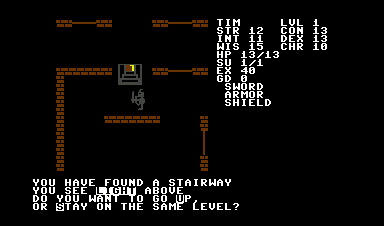 Telengard was released by Avalon Hill in 1982 for a variety of systems, including the TRS-80, Apple II, and the Commodore 64. It is considered the grandfather of dungeon crawls for computer gaming. It is a commercial version of "dnd", a mainframe computer game written by Daniel Laurence.
Telengard was released by Avalon Hill in 1982 for a variety of systems, including the TRS-80, Apple II, and the Commodore 64. It is considered the grandfather of dungeon crawls for computer gaming. It is a commercial version of "dnd", a mainframe computer game written by Daniel Laurence.
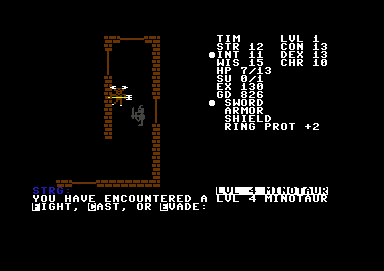 The game has a simple premise. You control an adventurer, a hero with both fighting and magical abilities. Your quest is to explore the vast subterranean complex of Telengard. Stairways up and down, teleporters, thrones, altars, fountains, grey misty cubes, and boxes with buttons lie scattered about. Monsters also await you in the depths, which will either attack, barter with you, or even steal from you.
The game has a simple premise. You control an adventurer, a hero with both fighting and magical abilities. Your quest is to explore the vast subterranean complex of Telengard. Stairways up and down, teleporters, thrones, altars, fountains, grey misty cubes, and boxes with buttons lie scattered about. Monsters also await you in the depths, which will either attack, barter with you, or even steal from you.
This is a very interesting classic game. I especially like the fact it pre-dates not only modern dungeon crawls like Diablo, but also NetHack, which I feel has become a little over-rated. I never had a chance to play Telengard until emulation became available, but I read a review of it in Compute! magazine back in the early 80's. I particularly admired the box cover artwork and the magazine advertisements, which were very colorful.
The sprawling labyrinth is 50 levels deep, with 200x200 rooms per level. That means there's over 2 million rooms! The dungeon is generated through a seeded algorithm so the same layout and objects can be found in each location, and no memory is wasted on static maps. (Modern game design could take a page or two from this technique.) This allows the program to run in a very tight amount of memory; the C64 version runs in BASIC with machine language extensions in 38k. The game has a nice expansive feel to it, like you're going to be exploring an exciting and dangerous place.
The principle game flaw is the pure randomness of encounters. It is extremely easy to run into a monster that far outlevels you, ending your game in an instant. There is nothing more frustrating in any game than to be slain by a random factor. Most incarnations of the game are written in BASIC, so it runs sluggishly. Because of the tight memory, Telengard lacks a developed class system, and no variety of armor or weapons, just stronger or weaker swords, armors, or shields. And a particular frustration was that only cassette saving was supported, which most emulators don't bother to do. (Saving state, if possible, should alleviate the problem.)
The DOS-PC version of Telengard can be found at Underdogs. A modern fan-created PC version is rumored to be in the works.
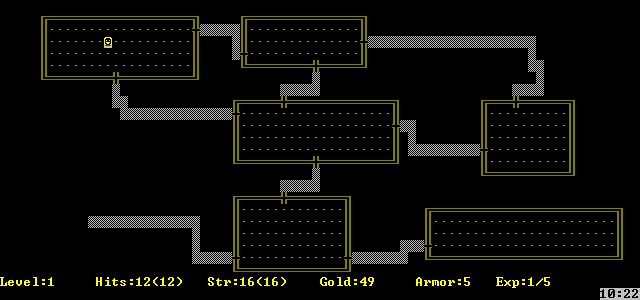 Written by Ken Arnold, Michael Toy, and Glenn Wichman, Rogue was similar to dnd, except that it existed on networked UNIX systems rather than mainframes. It continues to be popular today, especially its successor "NetHack". The game was also marketed by Epyx in the mid 80's to microcomputer platforms.
Written by Ken Arnold, Michael Toy, and Glenn Wichman, Rogue was similar to dnd, except that it existed on networked UNIX systems rather than mainframes. It continues to be popular today, especially its successor "NetHack". The game was also marketed by Epyx in the mid 80's to microcomputer platforms.
The premise was simple. Your character, a rogue, must journey into the Dungeon of Doom and retrieve the Amulet of Yendor on the 26th level. You consume food as you travel, and must find new sources of food in the dungeon, lest you faint from hunger at an inopportune moment. Magical potions, staves, wands, scrolls, and rings await your investigation. New weapons and armor can strengthen you for the next fight. Monsters have a variety of special abilities and behaviors, so different tactics are required for different circumstances.
Gameplay was on a top-down view, using ASCII characters instead of graphics. (Although graphic versions were later developed.) Monsters were depicted as capital letters, which meant that 26 different monsters existed. Every dungeon level was randomly generated; the first editions of Rogue had a predictable pattern set, but later editions featured much more chaotic dungeon designs. Like Ultima, Rogue also used a line-of-sight algorithm to block portions of the map as yet unexplored.
I really like Rogue for it's elegant simplicity and it's consistent replay value. The random factors with magical item descriptors that change every game really gives it a great feeling of consistency without stagnation. An interesting side-point is that the room corners were represented by a plus sign; in the modern PC game Diablo the junctures of corridors also have jutting edges, a homage of sorts to a classic predecessor.
Game flaws include a lack of a class system; like Telengard, memory considerations are the likely culprit for this. Gold found in-game mostly serves as a score-keeper. Because food is so important in the game, it's relatively easy for an impulsive player to run out at a bad moment, and starve to death.
I'm surprised no one ever wrote a TI version of Rogue; the character-based graphic system utilized would have been very easy to adapt. You can play an online version of classic Rogue at Hexatron. There is also the Rogue Archive, a repository of most versions of Rogue that have been released over the years.
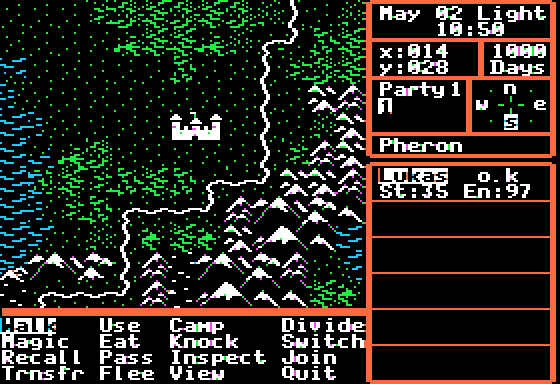 A marvelous game from Mindscape, the Magic Candle was released for the PC, Commodore 64, and the Apple II. I only recently discovered it, but went to the upmost effort to obtain an original copy of the game, despite it being freely available from Underdogs.
A marvelous game from Mindscape, the Magic Candle was released for the PC, Commodore 64, and the Apple II. I only recently discovered it, but went to the upmost effort to obtain an original copy of the game, despite it being freely available from Underdogs.
The story is that an evil demon, capable of destroying the world, has been trapped in a magical candle. It has been maintained by a group of wizards known as the Four and Forty for many centuries. Until one fateful day when one and all, they disappeared. Now the candle burns low, and your hero, Lucas, has been tasked to gather a party and discover a way to restore the candle before the demon can escape to unleash ruin upon the world.
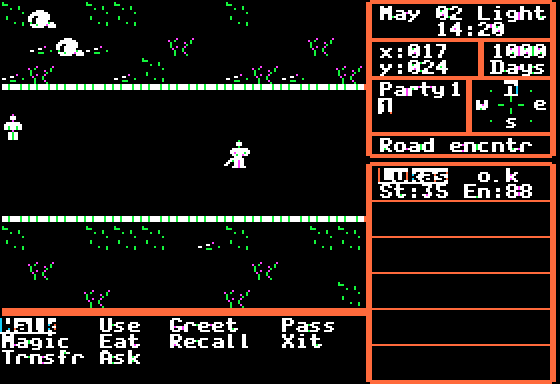 A class system exists, consisting of both professions and races, but instead of designing a party, your character chooses individuals from a group in the castle to join you on your quest. You can have up to six members in your party, and amazingly, you can even split your party into as many as six groups! This is useful because there are a number of non-combat tasks to do in the game, such as training, studying spells, and improving skills. By having half your party practice while the other gathers information or even fights, you save a lot of time. A second set of potential party members awaits you at a halfway point in the game.
A class system exists, consisting of both professions and races, but instead of designing a party, your character chooses individuals from a group in the castle to join you on your quest. You can have up to six members in your party, and amazingly, you can even split your party into as many as six groups! This is useful because there are a number of non-combat tasks to do in the game, such as training, studying spells, and improving skills. By having half your party practice while the other gathers information or even fights, you save a lot of time. A second set of potential party members awaits you at a halfway point in the game.
The spell system is particularly interesting. There are spellbooks, each of which contain six unique spells. A caster can memorize spells from the book and stack up multiple castings. Potential spells include both damage spells for combat as well as useful utilty spells.
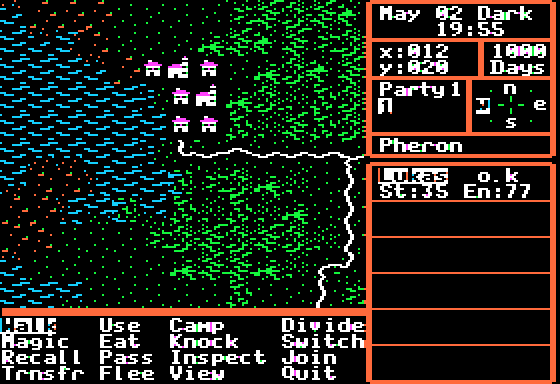 The world is a large overland map, consisting of two continents closely joined by a narrow bridge of land, and multiple islands and subcontinents to visit. Unlike Ultima, the world map view is more akin to a true "world view", with only an arrow pointing to your party's location. Night and day exist in game, which complicates your quest, as city gates are closed at night.
The world is a large overland map, consisting of two continents closely joined by a narrow bridge of land, and multiple islands and subcontinents to visit. Unlike Ultima, the world map view is more akin to a true "world view", with only an arrow pointing to your party's location. Night and day exist in game, which complicates your quest, as city gates are closed at night.
Conversations with NPC's can be complicated. The party member you use should have a high Charisma rating, otherwise he will get little information from anyone. Keywords can be used to elicit important information. There's a degree of randomness as well; sometimes someone will simply not want to speak to you.
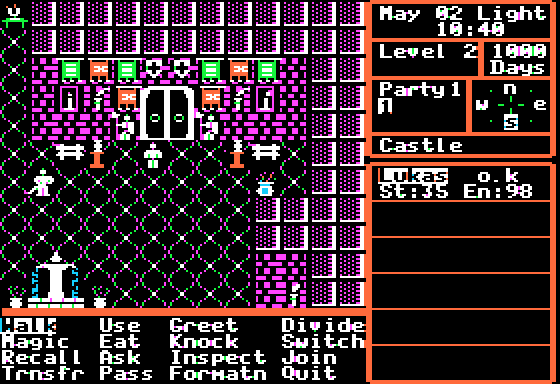 Combat is turn-based 2D tactical, very similar to Tunnels of Doom, but with even more intricate details. At the start of combat, you have the option to ready weapons, position your characters, and perform other "pre-combat" tasks. Your characters as well as monsters can dodge attacks, requiring them to move to an adjacent space. This means that boxing in enemies can prevent them from dodging. Ranged weapons are fired on straight-line tangents, and friendly fire is a dangerous possibility. The best way to win fights is to overwhelm the enemy at the start, so that they are unable to inflict any serious damage on your party. Using various magical mushrooms that exist in-game can restore your character's stamina and health at critical moments.
Combat is turn-based 2D tactical, very similar to Tunnels of Doom, but with even more intricate details. At the start of combat, you have the option to ready weapons, position your characters, and perform other "pre-combat" tasks. Your characters as well as monsters can dodge attacks, requiring them to move to an adjacent space. This means that boxing in enemies can prevent them from dodging. Ranged weapons are fired on straight-line tangents, and friendly fire is a dangerous possibility. The best way to win fights is to overwhelm the enemy at the start, so that they are unable to inflict any serious damage on your party. Using various magical mushrooms that exist in-game can restore your character's stamina and health at critical moments.
Game flaws are few, probably the worst is the relative complexity of the game. I have not yet played a full game through. From what I've read in help files on the net, the game has a very high learning curve for success. It is more profitable to stay in town and train up before going out into the world and fighting monsters, this could be frustrating for players who prefer a more impulsive play-style. The party system offers a great deal of unique characters, but not a lot of flexibility to make them your own. The towns are interesting, but the dungeons and towers seem more bland in comparison.
There are two sequels to the game, which were released for the PC. It's generally regarded that the first was the best of them, and that the magic of the series was slowly lost as it progressed. Despite this, I still feel the game is a monument of CRPG's simply for it's unique flavor and relative obscurity against the other giants like Ultima.
So, there's my short list, I hope you enjoyed it. In my next installment, I'll cover my aspirations for my CRPG, and some of the technical requirements involved.